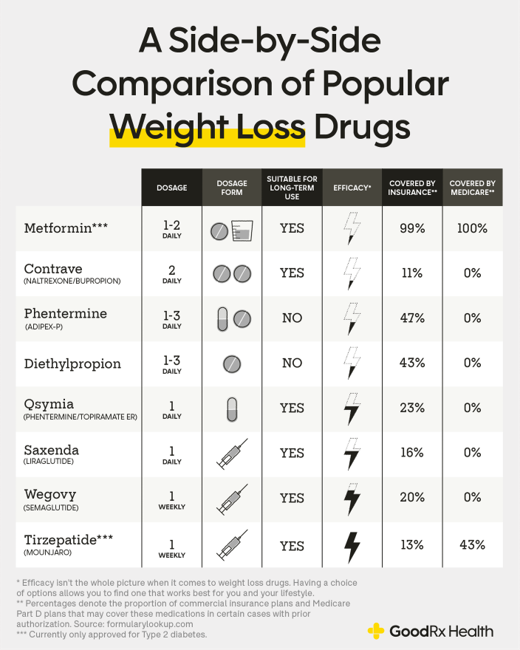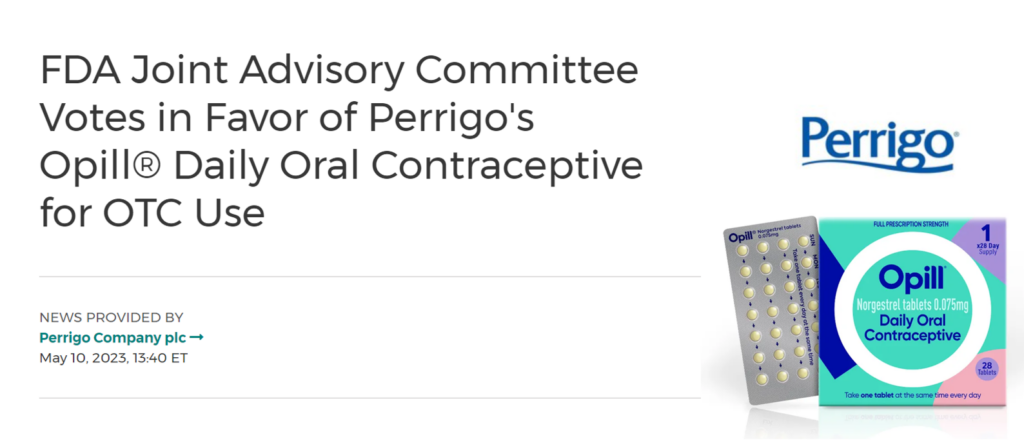We continue to track to evolving, expanding landscape of retail health — which we see as the expanding ecosystem of health/care accessible to people-as-health consumers. This week, three intriguing examples are resonating with us:
- The ever-evolving weight-loss industry
- FDA favors OTC use for Perrigo’s Opill daily oral contraceptive birth control pill
- The convergence of fashion and health — specifically, how an over-the-counter medicine converges with clothing that helps us feel better.

Let’s start with weight-loss, as several aspects of health/care come together in the consumer’s retail health sandbox. Dr. Eric Topol wrote about the category of GLP-1 drugs as “the new obesity breakthrough,” and added, “I’m not using the term ‘breakthrough’ lightly.”
In the past few months, we’ve witnessed the fast-uptake of the class of prescribed drugs known as GLP-1, with names you’ve seen in heavily-brand-advertised names like Mounjaro, Ozempic, and Wegovy.
Two key driving forces have turbocharged the fast- first, telehealth and digital therapeutics/new-fangled digital health companies have become part of the distribution channeling of these medicines beyond traditional physician prescribing workflows. The weight-loss category is a huge part of consumer-directed health care and spending, so these new brand name products are heavily DTC-advertised to consumers.
Thus, GoodRx put together this table comparing several weight loss drugs, from the most mature to the new-new things, as interested patients wearing healthcare payor hats need to understand the differences across the various choices — from dosage form to pricing.

Another key driving force propelling the adoption of the new weight loss meds has been social media, as this announcement from the TODAY show recently pointed out. TODAY connected the dots between the newly popularized meds with the fall of the once-popular weight loss franchise Jenny Craig — once the weight loss brand of stars like Kirstie Alley, Valerie Bertinelli and other celebrity “losers.”
The obesity drug industry is worth $200 bn in the next ten years, according to Barclays Bank, calling this “the story of the decade.”
In the meantime, the emergence of these prescription drugs will challenge the Old Guard of weight loss companies like WW (previously known as Weight Watchers), Nutrisystem, and other legacies of calorie-counting and packaged food subscriptions. Watch, too, for more online medical weight loss programs such as Calibrate which combines telemedicine with medication prescriptions; one of the company’s investors is Optum Ventures, telling us that payors are closely eyeing this lucrative and growing market.

Next, FDA reviewers found that the benefits of an over-the-counter birth control pill outweigh the risks, big news for patient empowerment and democratization of contraception. In 2022, Perrigo, maker of the Opill contraceptive, applied for the prescription medicine to be offered over-the-counter. The vote among members of the FDA Joint Advisory Committee (coupling the Nonprescription Drugs Advisory Committee with the Obstetrics, Reproductive, and Urologic Drugs Advisory Committee( was a unanimous 17 to 0.
FYI, the first birth control pill was approved by the FDA in 1960.

“Opill consists of 0.075 mg norgestrel, which has been used to prevent pregnancy in millions of women in the U.S. since it was approved by the FDA in 1973. Nearly 50 years of use and scientific evidence show that progestin-only pills such as Opill are effective at preventing pregnancy and are safe for most women to use,” Perrigo explained in the press release. The company’s OTC switch program has been eight years in the making, culminating in the publication of this research paper finding that of an OTC progestin-only pill could reduce the overall number of unintended pregnancies in the United States.
A key factor in the importance of the FDA’s determination is that one in three women have had problems obtaining a prescription or refilling one for a contraceptive, whether pill, patch, or ring, peer-reviewed research revealed. An OTC birth control pill has had the support of professional organizations that have long served women’s health, including the American Academy of Family Physicians, the American College of Obstetrics and Gynecology, and the American Medical Association.

Speaking of over-the-counter (OTC), the third impactful story in this retail health ecosystem update features the OTC cold-and-flu medicine, Mucinex, launch of Sickwear, a fashion-meets-health and self-care project. In the words of its press release, Mucinex Sickwear resulted from social commerce meeting over-the-counter medicine.
The Mucinex brand worked with the NYC agency Barbarian on this program, with the goal of evolving from health care product to a holistic wellness lifestyle brand
Mucinex’s agency Barbarian collaborated with fashion designers Steven Alan and Christina Viviani. who started with the question, “What does Mucinex do?” Answer: they make medicine to help people feel better.
Thus, as the tag asserts here, the line was conceived in the context of the Art and Science of feeling better. 
As Viviani tells her part of the story, she went straight to the tactile side of fashion that could indeed make us feel better.
Alan looked into colors that make people feel good, ending up with a palette of six tones in his fashion mix.
Viviani was also informed by the psychology behind colors, choosing navy blue as calming and spruce green which she learned was good for mental health. She was drawn to silk fabric, which regulates temperature and is naturally anti-microbial (who knew?).
Check out one of the Sickwear garments, the Zzzimono — think “sleep” (Zzzs) and “kimono,” fashioning a jacket with trapunto stitching, a pocket for tissues, and a built-in pillow in the hoodie.
Alan’s SlumpSuit is a stylized jumpsuit with a feel-good hood like a stretchy blanket and an aromatherapy pocket on the sleeve.
All eight garments were designed to be gender fluid, especially focusing on younger people looking for clothing that’s more comfortable, as well as stuff they’re proud to wear.
Here’s a link to Mucinex’s live launch of the project

Health Populi’s Hot Points: Perrigo has a 130-year history in consumers’ self-care for health. Today, its vision is clearly stated here: “to make lives better by bringing quality, affordable self-care products that consumers trust everywhere they are sold.”
What will resonate with patients-as-consumers in their embrace of retail health products and services are exactly these traits: quality, affordability, and trust….”everywhere,” being a convenience factor.
Stay tuned to the Health Populi blog as we continue to track and inform the growing retail health ecosystem.




 I am so grateful to Tom Lawry for asking me to pen the foreword for his book, Health Care Nation,
I am so grateful to Tom Lawry for asking me to pen the foreword for his book, Health Care Nation,  Thanks to Feedspot for naming this blog, Health Populi, as a
Thanks to Feedspot for naming this blog, Health Populi, as a